MARKETING
How to Run A Content Audit in 2022

As a marketer, how often do you run content audits? How do you keep track of how content is performing? Do you use those metrics to improve future campaigns?
If you’re missing this kind of organization for your company, consider investing in a content audit. They are an excellent planning resource and roadmap for future content creation. They also help you organize your analytics so you can refer back to high-performing posts if needed.
In this post, learn how you can perform a content audit for your own business, and discover high-quality tools to help you streamline the process. Keep reading, or use one of the links below to jump ahead to the section you’re looking for:
What is a content audit?
A content audit describes the process of collecting and analyzing assets on a website, such as landing pages or blog posts. Content audits keep an inventory of a website and provide insight into which content to create, update, re-write, or delete.
Content Audit Goals
Running a content audit for your website can boost your traffic and improve the experience of your readers.
First, content audits help you take note of the areas on your website that aren’t properly optimized for search engine rank. For example, you might add meta descriptions to your blog posts as part of your current strategy, but if that always wasn’t the case, a content audit helps you locate which posts need to be updated.
Content audits also help you find new SEO opportunities for your website. For example, did you know that adding keywords to the headings on your site gives search engines more clues about what your web page is about?
If search engines have as much knowledge as possible about the content on your website, they’ll be able to suggest your web pages to browsers more accurately.
Running an audit is a chance for you to update the content on your website to improve the comprehension of your site by readers. For example, you might not know the links on one of your product pages are broken, but a content audit provides you with a reminder to update those links. Let’s discuss some additional benefits below.
Benefits of Content Audits
Your content audit should help you bring your content up-to-date, improve the rank of your web pages, and make the website you present to readers easy to navigate and free of error. In addition, content audits:
- Give data-driven insight into the performance of your content, helping you make informed decisions based on factual information rather than just assumptions.
- Identify areas for content repurposing or updating where numbers are lower than desired.
- Highlight pieces of content that perform best that you can leverage in marketing materials.
- Understand more about what your audience likes and dislikes.
- Content maintenance becomes easier when you have an understanding of what you’re offering.
To make sure your website content audit is valuable, carve out enough time to complete it. However, you don’t have to be in it alone — there are plenty of templates to guide you through a content audit if you’re unsure of where to start.
Content Audit Template
To show you how a template can speed up the content audit process, let’s walk through HubSpot’s SEO Audit kit. It includes three useful tools:
- How to Run an SEO Audit guide
- On-page SEO template
- SEO audit checklist
The guide is a comprehensive overview of SEO audit principles and factors. It’s a great resource for both beginners and experienced content marketers looking for a refresher.
Next, to begin your content audit, open the on-page SEO template. This template guides you through checking the on-page SEO of your website.
The template has 16 sections, with instructions for each section.
Under each section, the template helps you understand what to look for and why it matters for on-page optimization. For example, if you note that you have multiple similar pages, the canonical tags section will help you make sure they’re grouped together.
Below, we’ll talk about the sections of the template.
Page Type

In the first column, you’ll specify your page type for each page you’re auditing. It works for many page types, like a home page, landing page, blog post, or even a form page.
URL

Then, you’ll fill in the URL.
Canonical Tags

Next, note any canonical tags your site may have. Remember, you can find canonical tags in your page’s source code.
Pagination

After that, you’ll note if your page is a part of a sequence of pages to ensure that your code is properly formatted for sequencing.
Page Title

Next up, you’ll fill in some details about the page’s copy. For instance, the page title. If I included a blog post similar to this one in the audit, for example, I would put “How to Run an SEO Content Audit” in this section.
This section makes sure you’ll have keywords in your page title, boosting SERP rank.
Page Purpose
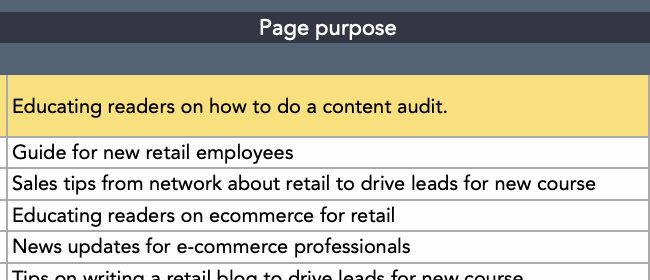
In this section, you’ll define the goal of each page.
So, for this blog post, I would define the purpose of this post in a short and descriptive sentence. For example, “Educating readers about how to do a content audit.”
Focus Keywords

Then I’d note the focus keywords of that page. My keywords for this post would be something akin to “On-Page SEO,” and “Content Audits.”
Headlines
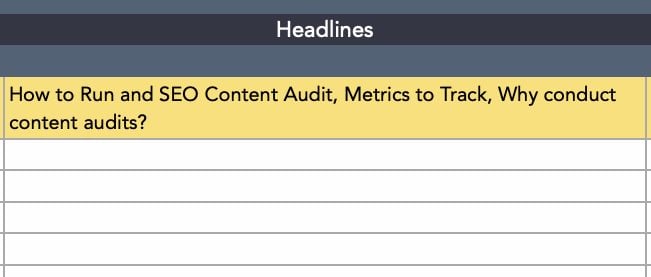
After that, you’ll note the headlines or title tags on your page. A good rule of thumb is to make sure at least one keyword appears in an H2 to help your rank.
Meta Descriptions
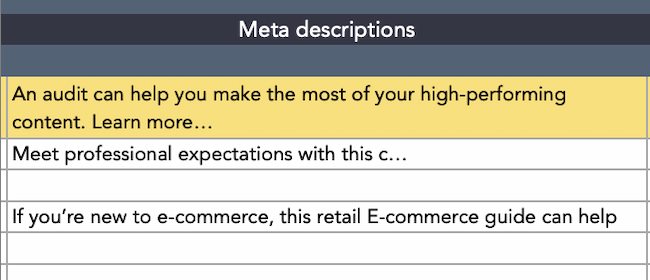
Take the same approach with meta descriptions. Add a short, concise description of your content. It should also contain a keyword to improve rank.
Images

Once you outline your headings and include your meta description, then you’ll focus on images. First, include the file name of your image and note the alt text. Recall that alt text tells Google what your image is about, so if your images don’t have any, this is a good reminder to add them.
Internal and Outbound Links
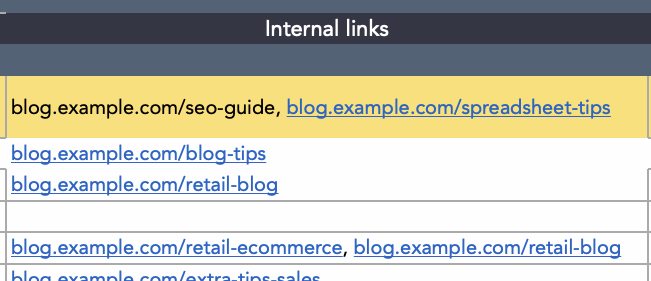
Next, you’re going to focus on links: internal and outbound. Remove broken internal links, and make sure your page has at least two or three. Remember, internal links help you to boost the traffic of other pages.
Page Speed

Following your link optimization, note the page speed. If your page takes longer than two seconds to load, it might not keep the reader’s attention.
Social Sharing

Next, make sure your page is available for sharing on social media.
Content

Review the contents of your page, paying special attention to the length of your copy and where and how you’re using keywords. This is also a chance to check for duplicate or similar content.
Mobile-friendly

Finally, check your page on mobile devices. This can help improve the accessibility of your webpage.
Once you’ve entered these details in your template, you’ll get a clear picture of what you can do to optimize your page. As you add more pages to the template, you may start to notice issues that come up repeatedly or holes in your content strategy.
For example, the “Images” section above shows that several posts are missing images and alt text. For those that have alt text, the copy isn’t optimized for some focus keywords.
This content audit data can help you form a data-driven foundation for strategy updates and recommendations.
Content Audit Spreadsheet
The SEO audit kit also offers a spreadsheet checklist. The SEO Audit Checklist helps you make sure the content of your website is fully optimized and up-to-date.
So, the template helps you update the on-page SEO of your website, while the checklist gives you an in-depth reference for running the audit.

This sheet will cue you on what to look for as you audit your site. It includes the following sections:
- Crawling and indexing audit
- On-page elements
- Ranking factors
- Content evaluation
- Link structure
- Status codes
- Scripts and coding
- Internationalization
These sections can help you understand what to look for as you audit your site. To use these checklists, you’ll simply mark “Yes” or “No” for each task, and add any notes to inform your action items.
How to Run a Content Audit
While a template can be extremely useful when auditing your content, each audit is unique, and many will use templates as a guide to create a more personalized process over time. The steps below can help you create a custom process to reach your content goals.
1. Think of your goals.
First, think about what you want to accomplish. When you have your goals in mind, you will have a better idea of how to categorize your audit later.
For example, if your goal is to increase brand awareness, you might audit your content with the goal of increasing branded keywords. Other goals to consider could be figuring out which pages need to be SEO-optimized or finding the best-performing website content to place on your homepage or in your email newsletters.
Ultimately, a content audit identifies engaging content for your audience. It can also include information on SEO and conversion rates. This process will help you see the strengths and weaknesses of your content and workflow.
Leading with company goals will ensure your content audit is useful for tracking and updating your strategy with improved tactics. After this is complete, then it’s time to collect your content.
2. Gather your content and create an inventory.
Which content are you going to audit? Content audits might include product descriptions, blog posts, video media, or online publications. Decide which content you want to audit and gather the backlog of that content.
Pulling your content together in an organized spreadsheet will create a content inventory. This will make it easier to track changes and goals for your content.
To start, collect URLs and other page information for the web pages you’ve chosen to audit. Page details you may want to collect to begin your audit include:
- Page title
- Content type
- Content format
- Word count
- Date last modified
- Linked CTAs
A content audit template can help you quickly pull together a content inventory to begin your audit. There are also online tools to help you collect this data, like SEMrush, Screaming Frog, and HubSpot.
Some tools will provide this information based on your sitemap. A site map is a file that has all your website’s information. You can usually create your sitemap for free online. For more information on this, check out this sitemaps guide.
3. Categorize your content.
After you gather your content, categorize it on the spreadsheet. Tracking every metric for every piece of content can get overwhelming quickly. So, use your goals to guide the categories you track for your audit.
Think of categories that offer useful insights from different pieces of content. For example, an SEO audit focuses on metrics like keywords, page speed, and backlinks. But if you’re running a content conversion audit, you may want to focus on traffic, click rate, and different types of conversions.
Some online tools will include metrics in audit data as well. Tools like Google Analytics can help you pull this data. Metrics can add value and context to your analysis.
Some online tools can categorize the information for you, but it’s often helpful to do it yourself. Adding relevant categories will keep you organized so your content audit meets your needs.
It can be tempting to add and remove categories throughout the process, but this can give you more data than you’re able to analyze. It’s also easy to start analyzing data before you’ve finished categorizing.
But these habits can also make the process more complex and time-consuming. They can also lead to hasty and incorrect analysis. If you notice interesting or surprising data, take a quick note, but keep categorizing before you start your analysis.
In this step, your goal is to complete a spreadsheet with the categories of data that you need to audit your content toward a specific goal.
4. Analyze your data.
Now, it’s time to look at your data critically. This is the step that will give you a good measure of the state of your content. When analyzing your data, here are some things to take note of:
- Content that’s missing — What is your audience interested in that you haven’t covered?
- Content that’s underperforming — Which pieces of content aren’t getting the numbers you want?
- Outdated content — If you have old content, can you update or rework it for optimization?
- Top content — Content that has performed extremely well.
Based on the results of this analysis, organize them in the spreadsheet. A way to do this is to assign different colors based on what you’re analyzing. Then, highlight the rows with those colors so you have an idea of which category is which. This can help you see which content takes up the largest part of your content library.
It’s also a good idea to scan your results for patterns, trends, and connections that can be hard to see when you’re looking at standard reports.
- Are there outlier posts whose performance exceeds expectations?
- Are there new topics that are getting more attention than they did a few months ago?
- Have organic backlinks spiked for specific content?
This information can help you recognize some of the happy accidents that are impacting your content performance. You can use this data to expand these ideas into your content strategy and tactics.
5. Create action items.
In this step, you will finalize and clean up your audit. You now know what to focus on based on the analysis and can go from there. Think about the posts to delete, update, re-write, or re-structure.
To organize these action items, add one last column to the spreadsheet — one that’s close to the front so you can keep tabs on it. This column will let you know the action to take on a specific URL. For example, are you going to keep, update, delete, or re-write that blog post?
If you plan on ranking by priority or including a timeline for this audit, now would be the time to include that. Some organizations use editorial calendars, while others choose a more casual approach.
To make a priority timeline that fits best with your content audit, think back to your initial goals and rank the items you want to execute first.
Keep this list of action items top of mind. That way your next content audit will show clear progress toward your goals, based on the data you found during your audit.
Content Audit Checklist
The graphic below is a checklist you can use to make sure you’re on the right track when performing your content audit.

Now, let’s go over some content audit tools you can use to further automate your content audit process.
Content Audit Tools
- Screaming Frog
- Ahrefs
- SEMrush
- Google Search Console
- Google Analytics
- WooRank
- Google Sheets
- Casted
- Vidyard
While not a requirement, choosing a content auditing tool can help you with your process. Rather than gathering URLs manually, the tool can automatically aggregate the content you’re looking for and display metrics for you to see.
But the most significant value of content audit tools is that they are fast, helping you save a considerable amount of time.
SEO Tools
1. Screaming Frog
Price: First 500 links free, unlimited for $209/year

Screaming Frog is a website crawler. It collects URLs from your sitemap and creates an SEO audit list for you. If you have a smaller site, Screaming Frog can audit up to 500 URLs for free.
The desktop Screaming Frog website is great because it provides a ton of analysis about your website and categorizes it for you.
2. Ahrefs
Price: Pricing for this tool starts at $99/month and they offer Lite, Standard, Advanced, and Enterprise plans.
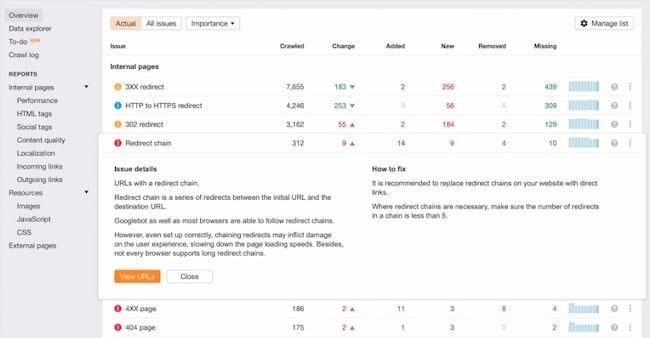
Ahrefs makes it simple to track your SEO site performance. It also offers powerful tools for keyword research, competitor analysis, and backlink tracking. You can export specific reports or track URLs, SEO performance, or groups of keywords with this useful audit tool.
3. SEMrush
Price: Free trial, then $120-$450/month
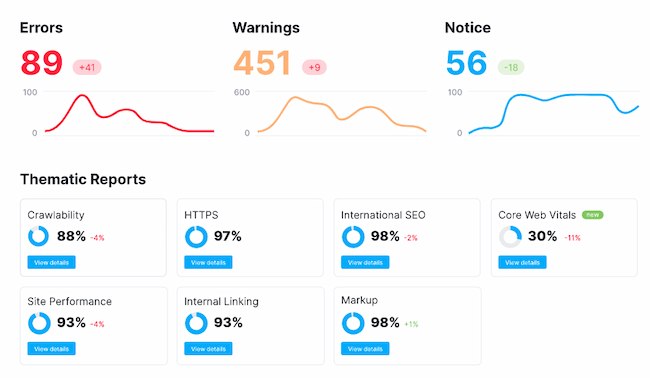
In three steps, users of SEMrush can receive a robust audit. By putting in the desired domain, you’ll get a customized report that shows you where you can improve your site:
From there, you can connect an analytics tool account, like Google Analytics. This can help if you want to see more information about your sitemap, like posts that are the most engaging for your audience. You can use this information when developing a strategy. It can help you find content that performs well for your audience.
4. Google Search Console
Price: Free

This tool makes it easy to track and analyze your website and search data. You can manually confirm that each page of your site is indexed and track URLs for useful data. The mobile usability issues features are also helpful during a content audit. You can also connect this tool to Google Analytics for more SEO insights.
Learn more about how to use Google Search Console with this useful post.
5. Google Analytics
Price: Free, with paid premium options

Google Analytics doesn’t give you a traditional audit, but it provides good information to help formulate your audit. It lets you know who is visiting your website, and from where. It also gives a rundown on the behaviors of your visitors:
Google is sunsetting Universal Analytics in 2023. The new version of this tool, called G4, uses data to predict user behavior and give you a clearer picture of your buyer journey.
It’s also important to know that Google Analytics creates reports with samples of your data, not exact data. This means that numbers on this tool may not match the numbers you may see in other content auditing tools.
Note: Another free Google tool, PageSpeed Insights, is a great way to track page speed on mobile and desktop devices.
6. WooRank
Price: Pricing for this tool starts at $80/month and they offer Pro, Premium, and Enterprise plans.

WooRank has two amazing features for content auditing: SEO monitoring and Site Crawler. SEO Monitoring from WooRank lets you know the performance of your landing pages. It also lets you know if your website ever goes down and how that’s affecting SEO. This is another metric to import if you’re tracking web page metrics in your audit.
The Site Crawl feature lets you know how Google sees your site and interprets the information for search engines. This information is great knowledge to make audits more effective when you’re coming up with action items for the future.
Content Organization Tools
7. Google Sheets
Price: Free
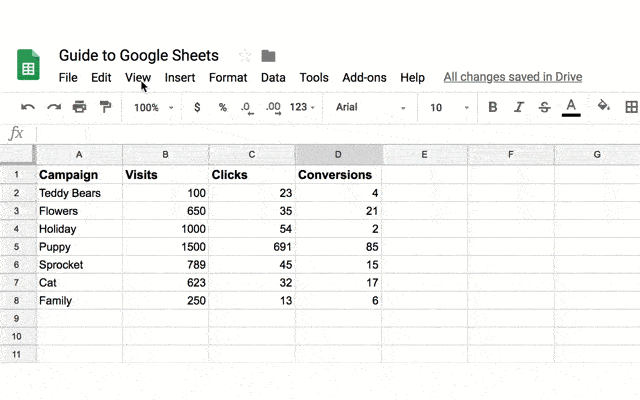
If you’re not used to spreadsheets, this useful online tool makes it easy to organize your content audit. This tool can help you:
- Tie together different data points from your content audit
- Let team members collaborate and comment on data
- Offers formulas and other tools to update critical metrics
If you’re not sure how to make the most of this tool, this guide to Google Sheets can help you get started.
Content Media Tools
8. Casted
Price: Contact sales for pricing on the Starter, Pro, and Enterprise plans.

Content audits aren’t just for blogs and web pages. Casted helps you understand how contacts are engaging with your podcast content. This can help you make actionable business decisions to drive engagement.
HubSpot customers: Casted integrates with Marketing Hub. You can use CRM tools to create lead capture forms to draw in your listeners for further nurturing.
9. Vidyard
Pricing: Free, with paid Pro and Business options

According to HubSpot research, 54% of companies plan to invest more in videos for TikTok this year, and another 56% are investing more in Instagram videos.
But no matter where you publish your videos, auditing your video content is essential, especially when trying to show ROI. Vidyard offers a comprehensive insights dashboard with visual analytics that you can use to audit your video content.
If you’re looking for more useful tools, this list of content marketing tools can help you organize and improve your content.
How to Do a Content Audit That Makes an Impact
You have the knowledge you need to perform content audits. You know how to create them, where to source them, and essentials to include. You’re fully prepared to use these audits in your organization for better content strategy and results. Give it a try, and use these tips to elevate your next campaign. Happy auditing!
Editor’s note: This post was originally published in September 2021 and has been updated for comprehensiveness.
MARKETING
Streamlining Processes for Increased Efficiency and Results

How can businesses succeed nowadays when technology rules? With competition getting tougher and customers changing their preferences often, it’s a challenge. But using marketing automation can help make things easier and get better results. And in the future, it’s going to be even more important for all kinds of businesses.
So, let’s discuss how businesses can leverage marketing automation to stay ahead and thrive.
Benefits of automation marketing automation to boost your efforts
First, let’s explore the benefits of marketing automation to supercharge your efforts:
Marketing automation simplifies repetitive tasks, saving time and effort.
With automated workflows, processes become more efficient, leading to better productivity. For instance, automation not only streamlines tasks like email campaigns but also optimizes website speed, ensuring a seamless user experience. A faster website not only enhances customer satisfaction but also positively impacts search engine rankings, driving more organic traffic and ultimately boosting conversions.
Automation allows for precise targeting, reaching the right audience with personalized messages.
With automated workflows, processes become more efficient, leading to better productivity. A great example of automated workflow is Pipedrive & WhatsApp Integration in which an automated welcome message pops up on their WhatsApp
within seconds once a potential customer expresses interest in your business.
Increases ROI
By optimizing campaigns and reducing manual labor, automation can significantly improve return on investment.
Leveraging automation enables businesses to scale their marketing efforts effectively, driving growth and success. Additionally, incorporating lead scoring into automated marketing processes can streamline the identification of high-potential prospects, further optimizing resource allocation and maximizing conversion rates.
Harnessing the power of marketing automation can revolutionize your marketing strategy, leading to increased efficiency, higher returns, and sustainable growth in today’s competitive market. So, why wait? Start automating your marketing efforts today and propel your business to new heights, moreover if you have just learned ways on how to create an online business
How marketing automation can simplify operations and increase efficiency
Understanding the Change
Marketing automation has evolved significantly over time, from basic email marketing campaigns to sophisticated platforms that can manage entire marketing strategies. This progress has been fueled by advances in technology, particularly artificial intelligence (AI) and machine learning, making automation smarter and more adaptable.
One of the main reasons for this shift is the vast amount of data available to marketers today. From understanding customer demographics to analyzing behavior, the sheer volume of data is staggering. Marketing automation platforms use this data to create highly personalized and targeted campaigns, allowing businesses to connect with their audience on a deeper level.
The Emergence of AI-Powered Automation
In the future, AI-powered automation will play an even bigger role in marketing strategies. AI algorithms can analyze huge amounts of data in real-time, helping marketers identify trends, predict consumer behavior, and optimize campaigns as they go. This agility and responsiveness are crucial in today’s fast-moving digital world, where opportunities come and go in the blink of an eye. For example, we’re witnessing the rise of AI-based tools from AI website builders, to AI logo generators and even more, showing that we’re competing with time and efficiency.
Combining AI-powered automation with WordPress management services streamlines marketing efforts, enabling quick adaptation to changing trends and efficient management of online presence.
Moreover, AI can take care of routine tasks like content creation, scheduling, and testing, giving marketers more time to focus on strategic activities. By automating these repetitive tasks, businesses can work more efficiently, leading to better outcomes. AI can create social media ads tailored to specific demographics and preferences, ensuring that the content resonates with the target audience. With the help of an AI ad maker tool, businesses can efficiently produce high-quality advertisements that drive engagement and conversions across various social media platforms.
Personalization on a Large Scale
Personalization has always been important in marketing, and automation is making it possible on a larger scale. By using AI and machine learning, marketers can create tailored experiences for each customer based on their preferences, behaviors, and past interactions with the brand.
This level of personalization not only boosts customer satisfaction but also increases engagement and loyalty. When consumers feel understood and valued, they are more likely to become loyal customers and brand advocates. As automation technology continues to evolve, we can expect personalization to become even more advanced, enabling businesses to forge deeper connections with their audience. As your company has tiny homes for sale California, personalized experiences will ensure each customer finds their perfect fit, fostering lasting connections.
Integration Across Channels
Another trend shaping the future of marketing automation is the integration of multiple channels into a cohesive strategy. Today’s consumers interact with brands across various touchpoints, from social media and email to websites and mobile apps. Marketing automation platforms that can seamlessly integrate these channels and deliver consistent messaging will have a competitive edge. When creating a comparison website it’s important to ensure that the platform effectively aggregates data from diverse sources and presents it in a user-friendly manner, empowering consumers to make informed decisions.
Omni-channel integration not only betters the customer experience but also provides marketers with a comprehensive view of the customer journey. By tracking interactions across channels, businesses can gain valuable insights into how consumers engage with their brand, allowing them to refine their marketing strategies for maximum impact. Lastly, integrating SEO services into omni-channel strategies boosts visibility and helps businesses better understand and engage with their customers across different platforms.
The Human Element
While automation offers many benefits, it’s crucial not to overlook the human aspect of marketing. Despite advances in AI and machine learning, there are still elements of marketing that require human creativity, empathy, and strategic thinking.
Successful marketing automation strikes a balance between technology and human expertise. By using automation to handle routine tasks and data analysis, marketers can focus on what they do best – storytelling, building relationships, and driving innovation.
Conclusion
The future of marketing automation looks promising, offering improved efficiency and results for businesses of all sizes.
As AI continues to advance and consumer expectations change, automation will play an increasingly vital role in keeping businesses competitive.
By embracing automation technologies, marketers can simplify processes, deliver more personalized experiences, and ultimately, achieve their business goals more effectively than ever before.
MARKETING
Will Google Buy HubSpot? | Content Marketing Institute

Google + HubSpot. Is it a thing?
This week, a flurry of news came down about Google’s consideration of purchasing HubSpot.
The prospect dismayed some. It delighted others.
But is it likely? Is it even possible? What would it mean for marketers? What does the consideration even mean for marketers?
Well, we asked CMI’s chief strategy advisor, Robert Rose, for his take. Watch this video or read on:
Why Alphabet may want HubSpot
Alphabet, the parent company of Google, apparently is contemplating the acquisition of inbound marketing giant HubSpot.
The potential price could be in the range of $30 billion to $40 billion. That would make Alphabet’s largest acquisition by far. The current deal holding that title happened in 2011 when it acquired Motorola Mobility for more than $12 billion. It later sold it to Lenovo for less than $3 billion.
If the HubSpot deal happens, it would not be in character with what the classic evil villain has been doing for the past 20 years.
At first glance, you might think the deal would make no sense. Why would Google want to spend three times as much as it’s ever spent to get into the inbound marketing — the CRM and marketing automation business?
At a second glance, it makes a ton of sense.
I don’t know if you’ve noticed, but I and others at CMI spend a lot of time discussing privacy, owned media, and the deprecation of the third-party cookie. I just talked about it two weeks ago. It’s really happening.
All that oxygen being sucked out of the ad tech space presents a compelling case that Alphabet should diversify from third-party data and classic surveillance-based marketing.
Yes, this potential acquisition is about data. HubSpot would give Alphabet the keys to the kingdom of 205,000 business customers — and their customers’ data that almost certainly numbers in the tens of millions. Alphabet would also gain access to the content, marketing, and sales information those customers consumed.
Conversely, the deal would provide an immediate tip of the spear for HubSpot clients to create more targeted programs in the Alphabet ecosystem and upload their data to drive even more personalized experiences on their own properties and connect them to the Google Workspace infrastructure.
When you add in the idea of Gemini, you can start to see how Google might monetize its generative AI tool beyond figuring out how to use it on ads on search results pages.
What acquisition could mean for HubSpot customers
I may be stretching here but imagine this world. As a Hubspoogle customer, you can access an interface that prioritizes your owned media data (e.g., your website, your e-commerce catalog, blog) when Google’s Gemini answers a question).
Recent reports also say Google may put up a paywall around the new premium features of its artificial intelligence-powered Search Generative Experience. Imagine this as the new gating for marketing. In other words, users can subscribe to Google’s AI for free, but Hubspoogle customers can access that data and use it to create targeted offers.
The acquisition of HubSpot would immediately make Google Workspace a more robust competitor to Microsoft 365 Office for small- and medium-sized businesses as they would receive the ADDED capability of inbound marketing.
But in the world of rented land where Google is the landlord, the government will take notice of the acquisition. But — and it’s a big but, I cannot lie (yes, I just did that). The big but is whether this acquisition dance can happen without going afoul of regulatory issues.
Some analysts say it should be no problem. Others say, “Yeah, it wouldn’t go.” Either way, would anybody touch it in an election year? That’s a whole other story.
What marketers should realize
So, what’s my takeaway?
It’s a remote chance that Google will jump on this hard, but stranger things have happened. It would be an exciting disruption in the market.
The sure bet is this. The acquisition conversation — as if you needed more data points — says getting good at owned media to attract and build audiences and using that first-party data to provide better communication and collaboration with your customers are a must.
It’s just a matter of time until Google makes a move. They might just be testing the waters now, but they will move here. But no matter what they do, if you have your customer data house in order, you’ll be primed for success.
HANDPICKED RELATED CONTENT:
Cover image by Joseph Kalinowski/Content Marketing Institute
MARKETING
5 Psychological Tactics to Write Better Emails

Welcome to Creator Columns, where we bring expert HubSpot Creator voices to the Blogs that inspire and help you grow better.
I’ve tested 100s of psychological tactics on my email subscribers. In this blog, I reveal the five tactics that actually work.
You’ll learn about the email tactic that got one marketer a job at the White House.
You’ll learn how I doubled my 5 star reviews with one email, and why one strange email from Barack Obama broke all records for donations.
5 Psychological Tactics to Write Better Emails
Imagine writing an email that’s so effective it lands you a job at the White House.
Well, that’s what happened to Maya Shankar, a PhD cognitive neuroscientist. In 2014, the Department of Veterans Affairs asked her to help increase signups in their veteran benefit scheme.
Maya had a plan. She was well aware of a cognitive bias that affects us all—the endowment effect. This bias suggests that people value items higher if they own them. So, she changed the subject line in the Veterans’ enrollment email.
Previously it read:
- Veterans, you’re eligible for the benefit program. Sign up today.
She tweaked one word, changing it to:
- Veterans, you’ve earned the benefits program. Sign up today.
This tiny tweak had a big impact. The amount of veterans enrolling in the program went up by 9%. And Maya landed a job working at the White House

Inspired by these psychological tweaks to emails, I started to run my own tests.
Alongside my podcast Nudge, I’ve run 100s of email tests on my 1,000s of newsletter subscribers.
Here are the five best tactics I’ve uncovered.
1. Show readers what they’re missing.
Nobel prize winning behavioral scientists Daniel Kahneman and Amos Tversky uncovered a principle called loss aversion.
Loss aversion means that losses feel more painful than equivalent gains. In real-world terms, losing $10 feels worse than how gaining $10 feels good. And I wondered if this simple nudge could help increase the number of my podcast listeners.
For my test, I tweaked the subject line of the email announcing an episode. The control read:
“Listen to this one”
In the loss aversion variant it read:
“Don’t miss this one”
It is very subtle loss aversion. Rather than asking someone to listen, I’m saying they shouldn’t miss out. And it worked. It increased the open rate by 13.3% and the click rate by 12.5%. Plus, it was a small change that cost me nothing at all.

2. People follow the crowd.
In general, humans like to follow the masses. When picking a dish, we’ll often opt for the most popular. When choosing a movie to watch, we tend to pick the box office hit. It’s a well-known psychological bias called social proof.
I’ve always wondered if it works for emails. So, I set up an A/B experiment with two subject lines. Both promoted my show, but one contained social proof.
The control read: New Nudge: Why Brands Should Flaunt Their Flaws
The social proof variant read: New Nudge: Why Brands Should Flaunt Their Flaws (100,000 Downloads)
I hoped that by highlighting the episode’s high number of downloads, I’d encourage more people to listen. Fortunately, it worked.
The open rate went from 22% to 28% for the social proof version, and the click rate, (the number of people actually listening to the episode), doubled.
3. Praise loyal subscribers.
The consistency principle suggests that people are likely to stick to behaviours they’ve previously taken. A retired taxi driver won’t swap his car for a bike. A hairdresser won’t change to a cheap shampoo. We like to stay consistent with our past behaviors.
I decided to test this in an email.
For my test, I attempted to encourage my subscribers to leave a review for my podcast. I sent emails to 400 subscribers who had been following the show for a year.
The control read: “Could you leave a review for Nudge?”
The consistency variant read: “You’ve been following Nudge for 12 months, could you leave a review?”
My hypothesis was simple. If I remind people that they’ve consistently supported the show they’ll be more likely to leave a review.
It worked.
The open rate on the consistency version of the email was 7% higher.
But more importantly, the click rate, (the number of people who actually left a review), was almost 2x higher for the consistency version. Merely telling people they’d been a fan for a while doubled my reviews.
4. Showcase scarcity.
We prefer scarce resources. Taylor Swift gigs sell out in seconds not just because she’s popular, but because her tickets are hard to come by.
Swifties aren’t the first to experience this. Back in 1975, three researchers proved how powerful scarcity is. For the study, the researchers occupied a cafe. On alternating weeks they’d make one small change in the cafe.
On some weeks they’d ensure the cookie jar was full.
On other weeks they’d ensure the cookie jar only contained two cookies (never more or less).
In other words, sometimes the cookies looked abundantly available. Sometimes they looked like they were almost out.
This changed behaviour. Customers who saw the two cookie jar bought 43% more cookies than those who saw the full jar.
It sounds too good to be true, so I tested it for myself.
I sent an email to 260 subscribers offering free access to my Science of Marketing course for one day only.
In the control, the subject line read: “Free access to the Science of Marketing course”
For the scarcity variant it read: “Only Today: Get free access to the Science of Marketing Course | Only one enrol per person.”
130 people received the first email, 130 received the second. And the result was almost as good as the cookie finding. The scarcity version had a 15.1% higher open rate.

5. Spark curiosity.
All of the email tips I’ve shared have only been tested on my relatively small audience. So, I thought I’d end with a tip that was tested on the masses.
Back in 2012, Barack Obama and his campaign team sent hundreds of emails to raise funds for his campaign.
Of the $690 million he raised, most came from direct email appeals. But there was one email, according to ABC news, that was far more effective than the rest. And it was an odd one.
The email that drew in the most cash, had a strange subject line. It simply said “Hey.”
The actual email asked the reader to donate, sharing all the expected reasons, but the subject line was different.
It sparked curiosity, it got people wondering, is Obama saying Hey just to me?
Readers were curious and couldn’t help but open the email. According to ABC it was “the most effective pitch of all.”
Because more people opened, it raised more money than any other email. The bias Obama used here is the curiosity gap. We’re more likely to act on something when our curiosity is piqued.

Loss aversion, social proof, consistency, scarcity and curiosity—all these nudges have helped me improve my emails. And I reckon they’ll work for you.
It’s not guaranteed of course. Many might fail. But running some simple a/b tests for your emails is cost free, so why not try it out?
This blog is part of Phill Agnew’s Marketing Cheat Sheet series where he reveals the scientifically proven tips to help you improve your marketing. To learn more, listen to his podcast Nudge, a proud member of the Hubspot Podcast Network.
-

 WORDPRESS7 days ago
WORDPRESS7 days agoTurkish startup ikas attracts $20M for its e-commerce platform designed for small businesses
-

 PPC7 days ago
PPC7 days agoA History of Google AdWords and Google Ads: Revolutionizing Digital Advertising & Marketing Since 2000
-

 MARKETING6 days ago
MARKETING6 days agoRoundel Media Studio: What to Expect From Target’s New Self-Service Platform
-
SEARCHENGINES6 days ago
Daily Search Forum Recap: April 12, 2024
-

 SEO5 days ago
SEO5 days agoGoogle Limits News Links In California Over Proposed ‘Link Tax’ Law
-

 MARKETING7 days ago
MARKETING7 days agoUnlocking the Power of AI Transcription for Enhanced Content Marketing Strategies
-

 SEARCHENGINES7 days ago
SEARCHENGINES7 days agoGoogle Search Results Can Be Harmful & Dangerous In Some Cases
-

 SEO4 days ago
SEO4 days ago10 Paid Search & PPC Planning Best Practices















![5 Psychological Tactics to Write Better Emails → Download Now: The Beginner's Guide to Email Marketing [Free Ebook]](https://articles.entireweb.com/wp-content/uploads/2023/02/11-Free-Email-Hacks-to-Step-Up-Your-Productivity.png)



You must be logged in to post a comment Login